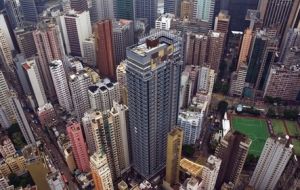MercoPress. South Atlantic News Agency
Chinese Mega City For 42 Million People
 The plan has been dubbed ‘Turn the Pearl River Delta Into One’
The plan has been dubbed ‘Turn the Pearl River Delta Into One’ Chinese city planners have announced a plan to merge cities surrounding the Pearl River Delta to create the world’s largest metropolis with 42 million people
The plan has been dubbed ‘Turn the Pearl River Delta Into One’, and will see nine cities combined into an urban area two times the size of Wales. The area is located on the Chinese mainland north of Hong Kong and Macau and includes the cities of Shenzhen, Guangzhou, Jiangmen, Huizhou, Dongguan, Huizhou, Zhongshan, Zhuhai and Zhaoqing.
The area spans some 16,000 square miles and accounts almost 20% of China’s economy. Once merged, the heavily industrious mega city will comprise an urban area more than 25 times the size of Greater London.
The idea is that when the cities are integrated, the residents can travel around freely and use the health care and other facilities in the different areas,“ said Ma Xiangming, the chief planner at the Guangdong Rural and Urban Planning Institute and a senior consultant on the project.
However, he said no name had been chosen for the area. ”It will not be like Greater London or Greater Tokyo because there is no one city at the heart of this megalopolis,“ he said. ”We cannot just name it after one of the existing cities.“
”It will help spread industry and jobs more evenly across the region and public services will also be distributed more fairly,“ he added.
Mr Ma said that residents would be able to use universal rail cards and buy annual tickets to allow them to commute around the mega-city.
Twenty-nine rail lines, totalling 3,100 miles, will be added, cutting rail journeys around the urban area to a maximum of one hour between different city centres. According to planners, phone bills could also fall by 85 per cent and hospitals and schools will be improved.
”Residents will be able to choose where to get their services and will use the internet to find out which hospital, for example, is less busy,“ said Mr Ma.
Pollution, a key problem in the Pearl River Delta because of its industrialisation, will also be addressed with a united policy, and the price of petrol and electricity could also be unified.
The southern conglomeration is intended to wrestle back a competitive advantage from the growing urban areas around Beijing and Shanghai.
By the end of the decade, China plans to move ever greater numbers into its cities, creating some city zones with 50 million to 100 million people and ”small” city clusters of 10 million to 25 million.
In the north, the area around Beijing and Tianjin, two of China's most important cities, is being ringed with a network of high-speed railways that will create a super-urban area known as the Bohai Economic Rim. Its population could be as high as 260 million.
The process of merging the Bohai region has already begun with the connection of Beijing to Tianjing by a high speed railway that completes the 75 mile journey in less than half an hour, providing an axis around which to create a network of feeder cities.
As the process gathers pace, total investment in urban infrastructure over the next five years is expected to hit £685 billion, according to an estimate by the British Chamber of Commerce, with an additional £300 billion spend on high speed rail and £70 billion on urban transport.




Top Comments
Disclaimer & comment rules-

-

-

Read all commentsthis would be far to big, and will allow things to spread far to quickly,
Jan 30th, 2011 - 09:53 pm 0but that’s china for you, think big built big
just amazing
Jan 31st, 2011 - 06:52 am 0This would be the size of São Paulo (itself a mega-city) if it became expanded in all directions to encompass from Santos, SP on the coast to 90 Km beyond Campinas!
Jan 31st, 2011 - 04:15 pm 0Nossa! Imagine laying the foundations of a First World new mega-city across the State - SP and dozens of major and minor towns - the investment! The infrastructure!
Commenting for this story is now closed.
If you have a Facebook account, become a fan and comment on our Facebook Page!